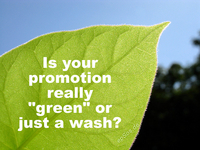Marketers must be mindful of the dangers of 'greenwashing'
You don’t have to look far to see examples of green marketing — they're all around you. Plastic bags that decompose, Forest Stewardship Council-certified paper, and bio-based cleaners all have something in common — they are green and can prove their products are less harmful than their non-green counterparts.

Courtesy of epSos.de on Flickr
However when a company actively engages in greenwashing — the promotion of a product based on misleading "green" claims — it's looking to deceive the user into believing it's helping the environment, when in fact it may be contributing more to its decline. Sometimes the promotion is unintentional, such as a promotion plan that was not well thought out.
Let’s take a look at a few greenwashing examples for analysis, with links for further details.
Adding the term — green, eco-, environmental, bio-, organic and others to your promotion, but the truth is your product or service has little to do with anything green.
Example: Eco-Conscious Female Doll. In 2008 a large toy producer was ecstatic to introduce their latest version of their toy — a doll whose accessories were partially made by excess fabrics and trimmings from their other doll accessories. Problem was, no one saw this as an eco-friendly product. Most of the product, including the doll and accessories are made from plastic (oil consumption and chemicals), very little reused product was put into the new products, and it was all made in China. This led to numerous posts on blogs (especially the mom blogs) and other web sites identifying this as a greenwash by the company. Negative publicity by bloggers and anti-greenwash sites with high readership only hurts your brand or product.
Adding the color green to your logo, literature, name etc. — “if you paint it green, they will buy” attitude.
Example: A cleaning product that has been around for several decades not only used the color green as part of its labeling but also used the word "green" in its product, long before it was cool to use the term and the color. The marketing worked and still does — a lot of people think this product is healthy and good to use in your home. However if you use this product without wearing a mask, you will quickly learn something is not so green about this product.
Adding a leaf or a tree to your promotional messages — probably the most common and simplest-to-execute greenwashing technique.
This example actually hits the trifecta of greenwashing. 1. Added green terminology 2. Added green color 3. Added a leaf to the messageThese diapers were touted to be organic, hypoallergenic, latex and fragrance free, and a host of other claims that somehow made it green. However, as many noted — organic wasn’t backed up by being certified organic, nor did the company state how much of the materials were organic. The packaging and inks were not green friendly, and the biggest fail of this product's greenwashing attempt: The diapers were not biodegradable, which would have made this product a win.
Sadly, all of these promotion types work. People buy into the hype because it is easy and they don’t look beyond the claims associated with the promotion. However for those that are informed and looking for greenwashing — not only do they spot it, but they blog about it, they tell their friends about it, and they send a message to anti-greenwashing websites. Negative perceptions of your product are not the goal. Make your product or service a real ecologically healthy product and then eco-promote.
Further reading:
The seven sins of greenwashing.
A branding primer: Green is a color. Sustainability is a practice.
FTC proposes crackdown on greenwashing.
Kim Kachadoorian also known as the "Geeky Marketer" is an “in-transition” marketer looking for her next gig. In the meantime, she maintains her Geeky Marketer website and blog as part of her DNA and she maintains a job-hunting blog — Jobs in A2. She found that helping others was a good way to use her talents and keep her skill set fresh. She'll be sharing them with readers of AnnArbor.com's Business Review on a regular basis.


Comments
Kim Kachadoorian
Thu, Feb 10, 2011 : 1:17 p.m.
@FattyJ - what you are describing is a hidden form of greenwashing - kind of like a product that says "no added sugar" -then they charge you more for saving them the cost of the sugar - an upside down relationship in my mind. I want marketers to be ethical. Greenwashing is one of my pet peeves!
FattyJ
Thu, Feb 10, 2011 : 7:06 a.m.
Marketing the green revolution is easy. They can make a cheaper product in many cases and charge a higher price because of consumer ignorance. It's a "feel good" revolution, which does very little for the environment.
Kim Kachadoorian
Wed, Feb 9, 2011 : 10:57 p.m.
@braggslaw - for the most part, I agree with you. There are more terrible examples than really good examples. There are some real green skin care products but most are sold in plastic that isnt' recycled or cannot be recycled. One of the greenest products I like to use - good old fashioned baking soda - even comes in a recycled box that can be recycled yet again.
braggslaw
Wed, Feb 9, 2011 : 8:49 p.m.
I don't think anybody really knows what "Green" really is. Many think organic food or the compulsory recycling of plastic and paper is green, when in reality they are not. "Green" is another marketing tool used to herd the sheep into buying products.
Kim Kachadoorian
Wed, Feb 9, 2011 : 7:17 p.m.
Link to image used in article <a href="http://www.flickr.com/photos/epsos/3384297473/" rel='nofollow'>http://www.flickr.com/photos/epsos/3384297473/</a>